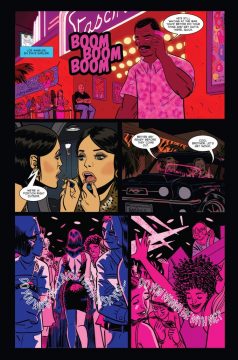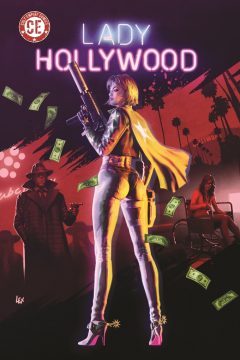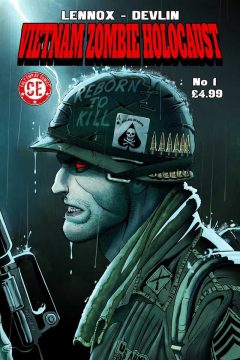“I always rooted for gutsy female leads” George Lennox and Russell Mark Olson talk Lady Hollywood, 80s LA noir and hard boiled detective fiction!
 After discovering the vintage sci-fi brilliance of Gateway City at this year’s True Believers, we were even more ecstatic to discover artist Russell Mark Olson has also been turning his hand to the 80s LA noir of Cult Empire’s new series Lady Hollywood. As it entices new readers in via Kickstarter thanks to it’s neon colours and in your face action, we catch up with Russell and writer/publisher George Lennox to find out more about this enticing new heroine!
After discovering the vintage sci-fi brilliance of Gateway City at this year’s True Believers, we were even more ecstatic to discover artist Russell Mark Olson has also been turning his hand to the 80s LA noir of Cult Empire’s new series Lady Hollywood. As it entices new readers in via Kickstarter thanks to it’s neon colours and in your face action, we catch up with Russell and writer/publisher George Lennox to find out more about this enticing new heroine!
 Lady Hollywood is set in the seedy underbelly of Hollywood and features a ‘honey trap’ expert who blackmails cheating men – can you tell us a bit about the inspiration for this? Was the idea of a honey trapper the main inspiration or was it a desire to write a really classic LA Crime story?
Lady Hollywood is set in the seedy underbelly of Hollywood and features a ‘honey trap’ expert who blackmails cheating men – can you tell us a bit about the inspiration for this? Was the idea of a honey trapper the main inspiration or was it a desire to write a really classic LA Crime story?
George Lennox: The inspiration for this story came from my own love of crime novels, real life crime, exploitation cinema and my own personal experiences travelling in LA. With the honey trap story, this came from experiences that happen every day with private detectives so I thought this would be an interesting angle to introduce and develop our characters. Kate (Lady Hollywood) and Whalen take on these types of jobs only because they pay the bills, but they aren’t blackmailers, they just get evidence for clients who hire them to try catch their partners cheating.
It feels quite interesting having a female lead for this kind of genre book. Was it important for you to switch things up and make the character different from your average down on their luck male private eye?
GL: This character really excites me as I’ve sat on this book for a few years now. When I first came up with the lead I wanted to try to show a strong female character who is working in a male dominated environment and how she overcomes all these challenges from day to day. I can’t go into too much detail with how the plot develops, as something shocking happens in the first three pages of Issue 2. This leads to us finding out why Kate is the way she is and it really throws Kate onto a path that has her having to face up to demons she has locked away. This was one of the things I was really pleased with how Russell tackled the character. I felt he got it and also got what I was trying to show, whereas perhaps someone else would have felt the need to play it differently. Plus, growing up I always rooted for gutsy female leads with the likes of Sigourney Weaver, Pam Grier and my own personal favourite, Meiko Kaji.
 Russell Olson: Though I didn’t write the story or script, one of the things that most attracted me to this story was the strong female lead. With Gateway City, although I have storylines planned with strong female characters, I’ve yet to write an episode centred around one of them. Lady Hollywood allowed me the opportunity to step away from the traditional tropes and produce something more varied. One of the things I’ve tried to balance while interpreting George’s script is the lead’s multiple personalities. I should explain that: Kate is a strong, intelligent, resourceful woman who works as a private investigator. But she often has to acknowledge and play to the male gaze for specific cases. This has been my biggest challenge; to represent her as a fully developed character at all times, even when she is representing herself as an object during a honey trap. I hope I’ve managed to execute this, giving her the respect she deserves.
Russell Olson: Though I didn’t write the story or script, one of the things that most attracted me to this story was the strong female lead. With Gateway City, although I have storylines planned with strong female characters, I’ve yet to write an episode centred around one of them. Lady Hollywood allowed me the opportunity to step away from the traditional tropes and produce something more varied. One of the things I’ve tried to balance while interpreting George’s script is the lead’s multiple personalities. I should explain that: Kate is a strong, intelligent, resourceful woman who works as a private investigator. But she often has to acknowledge and play to the male gaze for specific cases. This has been my biggest challenge; to represent her as a fully developed character at all times, even when she is representing herself as an object during a honey trap. I hope I’ve managed to execute this, giving her the respect she deserves.
We’re guessing you’re quite big crime noir fans? What books or films inspired your take on LA in Lady Hollywood? We’re guessing James Ellroy, Elmore Leonard, Brubaker/Philips, Raymond Chandler, Michael Mann, Chinatown and more recently Inherent Vice?
GL: Yeah I’m a big fan of crime noir. All of the names you mentioned above are people I respect and I personally love all their work, especially James Ellroy and Elmore Leonard. Although for me my favourite American crime writer is Edward Bunker who was best known for his books No Beast So Fierce, Little Boy Blue, The Animal Factory and Dog Eat Dog. Bunker’s hard-boiled unapologetic approach tells you he’s giving it to you straight, but he also manages to write about how people get caught up in crime and explains it in a way that we understand how and why these characters get caught up and lost in the system. That’s one of the themes in Lady Hollywood; yes, we have lots of characters who have their own issues, but there is a logic to why these characters have chosen the path they are about to go down. In Lady Hollywood there are no good guys or bad guys, just people trying to survive. I find that really interesting and I think when people read this comic it will be a world they will want to find out more about and maybe open their eyes up to what kind of world is out there.
 RO: Crime Noir and Hardboiled Detective Fiction excite me like no other genre. My favourite books are the Continental Op stories by Dashiell Hammett. I know that everyone says Chandler does everything better than Hammett, but I think most who say that have only ever read The Maltese Falcon. Red Harvest is the work that engendered my love of private detectives, plot twists and human motivations. Lady Hollywood has quite a few echoes. I don’t want to give too much away, but there’s a kind of Judo-esque art to the detective stories I most admire which is played out in LH: the detective (or in Crime Noir, very often the Femme Fatale) rarely resorts to brute force or direct confrontation. In Red Harvest, the Continental Op causes maximum damage without hardly ever using a weapon. Instead, he plants a rumour here, an idea there. Insinuates this and recommends that. In the end, his greatest weapon is his understanding of human psychology. What I think is fascinating about Lady Hollywood, is that there are multiple characters, both protagonist and antagonist, who possess these skills and I can’t wait for readers to see how they play out.
RO: Crime Noir and Hardboiled Detective Fiction excite me like no other genre. My favourite books are the Continental Op stories by Dashiell Hammett. I know that everyone says Chandler does everything better than Hammett, but I think most who say that have only ever read The Maltese Falcon. Red Harvest is the work that engendered my love of private detectives, plot twists and human motivations. Lady Hollywood has quite a few echoes. I don’t want to give too much away, but there’s a kind of Judo-esque art to the detective stories I most admire which is played out in LH: the detective (or in Crime Noir, very often the Femme Fatale) rarely resorts to brute force or direct confrontation. In Red Harvest, the Continental Op causes maximum damage without hardly ever using a weapon. Instead, he plants a rumour here, an idea there. Insinuates this and recommends that. In the end, his greatest weapon is his understanding of human psychology. What I think is fascinating about Lady Hollywood, is that there are multiple characters, both protagonist and antagonist, who possess these skills and I can’t wait for readers to see how they play out.
How did you and Russell team up on this book? And what’s the working relationship been like?
GL: To be honest I had been trying to find the right artist for a while. Eli Winter (who is the Editor on the book) and I had a lot of discussions about it as I felt we needed someone who would not only understand the script but they also needed to understand LA. Luckily for me, I came across Russell’s Gateway City online and once I saw his beautiful artwork I knew this would be the perfect style for Lady Hollywood. I then approached Russell about the project and we both just clicked into gear. That’s rare in comics as everyone is different, some can be cliquey, some can be difficult but we have a really strong working relationship, one with trust, respect and we both have a really good discipline toward the work. As a writer, making independent comics is always difficult and can sometimes add strain on the project due to taking on too much work, but I can honestly say this book has been a joy to make. Russell and I just hit it off and with the help of Eli, Alex and Emily, I feel this book complements the whole team.

RO: (I’ll let George field this one, I’ll only add:) I’ve been drawing my own stories for so long that I must admit I was a bit worried I would discover that my skills had developed in a vacuum and were ill-suited for collaboration. I was quickly relieved by how easy this book developed. George is a great communicator and very direct. In some ways, I think my Americanness and his Scottishness are perfectly suited for collaboration. We both seem to cut right to the chase without sacrificing the development of a friendship. I trust him and I think he trusts me. It’s been a blast.
Russell, how does working on a present day noir story differ to your more vintage work on Gateway City? Is it just a matter of changing your colour palette from vintage hues to neon pinks and blues?
RA: There’s a bit of that. I watched a lot of 80s noir (Blue Velvet, Roger Rabbit, Two Jakes, Blood Simple, etc) while drafting layouts. The camera angles of Gateway City are, in an oblique way, mostly based on The Third Man. For Lady Hollywood, I wanted something that screamed LA and, to me, nothing screams LA like the 1980s and the Italian-based designs of the Memphis Group. So, although the story is present day, I wanted it to feel like my childhood memories of what I thought LA should look like. That meant neon, geometric shapes, sunglasses, pattern. I love how neon lends itself to noir: in order to get vivid colours, you’ve gotta have dark darks. And where you have darks, you’ve got places to hide your baser instincts.
 Do you have to do much research on this one to get the locations and scenes accurate?
Do you have to do much research on this one to get the locations and scenes accurate?
RO: Ye—es. And no. Not nearly as much research as on a period piece. As much as I hate our current Googlestate, to get research for modern-day stuff is as simple as typing out exactly what you’re looking for and pressing “search.” The key is knowing exactly what you’re looking for…and being ready to admit that the idiomatic idea of certain things (settings, clothing, cars) one keeps in their head are actually inaccurate and may not exist.
It’s quite a departure from the more horror centric books that Cult Empire have done so far. Was this an intentional thing to broaden your output or just a reflection of the books you love?
GL: My goal for Cult Empire Comics is to create alternative comics and to focus on different genres with interesting characters we can develop further. Our first titles, Vietnam Zombie Holocaust, Horror Show and Vampires Everywhere are all titles I had written many years ago and felt the need to do first. This year will also see us publish more creator owned comics so that’s really exciting times for Cult Empire and it will bring a balance to our collection so far.
And finally how long is the series planning to run for? And what can people look forward to on the Kickstarter in terms of rewards and stretch goals?
GL: Lady Hollywood was originally a sixty-page graphic novel but it was only once I started to see Russell’s beautiful pages that I felt we had the opportunity to have a four part series. This gives us a chance to develop all the characters further and it gives us a proper graphic novel. Our Kickstarter campaign has been really positive so far, as my main aim was to try push our comics to the front and showcase our backlog titles. We had a really cool pledge – offering someone the opportunity to becoming a villain or a gangster in issue 2, with a few people taking up the offer. We managed to make our target and get funded, so we have planned some cool stretch goals. Our first stretch goal is if we can make £1500 then everyone that has already spent £5 or above will receive a special print by Russell. Our second stretch goal is for £2500 and if we hit that target it will unlock an exclusive Kickstarter edition cover that will only be sold through Kickstarter.
You can back the Lady Hollywood Kickstarter here. Or purchase issue #1 from the Cult Empire Comics store here.



October 8, 2025 @ 8:12 pm
I love the structure of your explanation. Watch live cricket for star sports — IPL and international cricket. quick start and stable playback. interviews, stats and tables, key moments. quick start and stable playback.